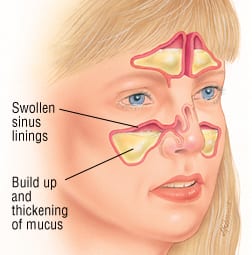1. There is no significant difference in treatment failure rates in pediatric patients taking amoxicillin versus amoxicillin-clavulanic acid for acute sinusitis.
2. Adverse events were more common in patients taking amoxicillin-clavulanic acid compared with amoxicillin.
Evidence rating level: 2 (good)
Research outline: Acute sinusitis is a common condition in children and is frequently treated with antibiotics, although there is no consensus on the optimal empiric antibiotic. This study aimed to compare the effectiveness and safety of two commonly used antibiotics, amoxicillin-clavulanate and amoxicillin, in the treatment of acute sinusitis in children, with amoxicillin-clavulanic acid representing the broader spectrum antibiotic. The primary measurable outcome was treatment failure, defined as the total number of instances in which a patient had to take a new antibiotic, visit the emergency room, or be hospitalized for acute sinusitis or its complications. This cohort study found no statistically significant difference in treatment failure rates between the two antibiotics. However, amoxicillin-clavulanic acid is associated with an increased risk of adverse events, particularly gastrointestinal symptoms and yeast infections. A limitation of this study is that data on dose (weight-based, standard vs. high dose) were not captured, which may have affected treatment failure due to between-group differences. Nonetheless, these findings provide relevant guidance for health care practitioners responsible for selecting empiric antibiotics to treat acute sinusitis in pediatric patients.
Click to read the study in JAMA
Related Reading: Identifying children who may benefit from antibiotic treatment for acute sinusitis
Drill Down (Retrospective Cohort): This cohort study analyzed data from a national database of 320,141 children and adolescents in the United States from 2017 to 2021. The primary focus is to assess treatment failure within 2 weeks of initial antibiotic prescription. To account for potential confounders, propensity score matching was performed. The study showed that the treatment failure rate was 1.7% in the amoxicillin-clavulanic acid group and 1.8% in the amoxicillin group. Importantly, there was no statistically significant difference in the risk of treatment failure between the two groups. The most significant difference was observed in adverse events, with amoxicillin-clavulanic acid recipients having a 1.15-fold higher risk of any adverse event. Further analysis stratified by age revealed a unique pattern, with adolescents aged 12 to 17 years benefiting from a significantly reduced risk of adverse events with amoxicillin-clavulanic acid, while younger age groups showed a different risk profile. These findings provide valuable insights into empiric antibiotic selection for acute rhinosinusitis and highlight the complex interplay between age and potential side effects in clinical decision-making.
Image: PS
©2023 2 Minute Medicine, Inc.. all rights reserved.No work may be reproduced without express written consent 2 Minute Medicine, Inc..Ask about licensing here. No article should be construed as medical advice, nor is it intended by the author or 2 Minute Medicine, Inc. to do so.

